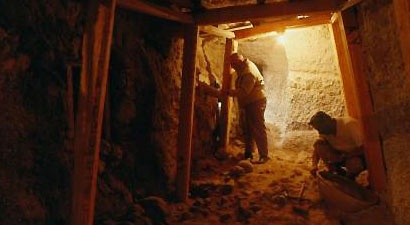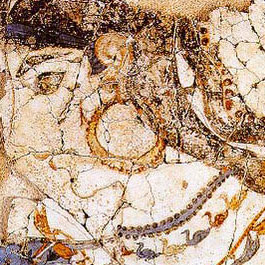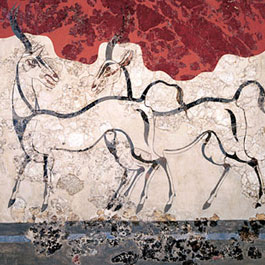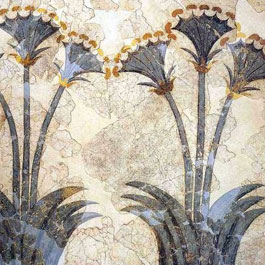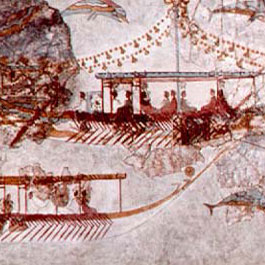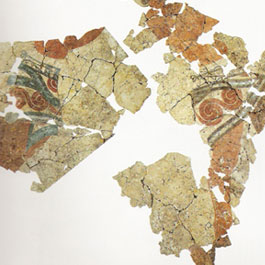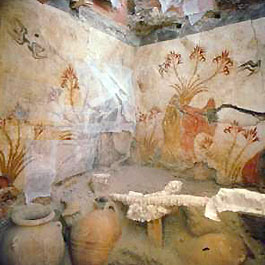BEST OF SANTORINI ISLAND HOLIDAYS | MEMBER OF SANTORINI® WEB
Archaeology / Akrotiri Digs
| Santorini Archaeological Sites : Akrotiri Excavations |
| The excavations at Akrotiri have
uncovered one of the most important prehistoric settlements
of the Aegean. The first habitation at the site dates from
the Late Neolithic times (at least the 4th millennium BC).
During the Early Bronze Age (3rd millennium BC), a sizeable
settlement was founded and in the Middle and early Late Bronze
Age (ca. 20th-17th centuries BC) it was extended and gradually
developed into one of the main urban centers and ports of
the Aegean.
The large extent of the settlement (ca. 20 hectares), the
elaborate drainage system, the sophisticated multi-storeyed
buildings with the magnificent wall-paintings, furniture and
vessels, show its great development and prosperity.
The various imported objects found in the buildings indicate
the wide network of its external relations. Akrotiri was in
contact with Crete but also communicated with the Greek Mainland,
the Dodecanese, Cyprus, Syria and Egypt.
The town's life came to an abrupt end in the last quarter
of the 17th century BC when the inhabitants were obliged
to abandon it as a result of severe earthquakes. The eruption
followed. The volcanic materials covered the entire island
and the town itself. These materials, however, have protected
up to date the buildings and their contents, similar to Pompeii.
|
|
|
Evidence of habitation at Akrotiri first came to light in the
second half of the 19th century. However, systematic excavations
were begun much later, in 1967, by Professor Spyridon Marinatos
under the auspices of the Archaeological Society at Athens.
He decided to excavate at Akrotiri in the hope of verifying
an old theory of his, published in the 1930's, that the eruption
of the Thira volcano was responsible for the collapse of the
Minoan civilization. Since his death in 1974, the excavations
have been continued under the successful direction of Professor Christos Doumas. |
|
| The Most Important Buildings of the Site are : |
| Xeste 3 |
| Large edifice, at least two-storeys
high, with fourteen rooms on each floor. Some of rooms were
connected by multiple doors and decorated with magnificent wall-paintings.
In one of them there was a "Lustral basin", which
is considered a sacred area. One may conclude that Xeste 3 was
used for the performance of some kind of ritual. |
|
| Sector B |
| Possibly comprises two separate
buildings, the one attached to the other. From the first floor
of the western building, came the famous wall paintings of
the Antelopes and the Boxing Boys. The eastern building yielded
the “Fresco of the Monkeys”, a composition of monkeys climbing
on rocks at the side of a river. |
|
| House of the Ladies |
| The large two-storeyed building was
named after the fresco with the Ladies and the Papyrus(Cyperus
Papyrus), which decorated the interior. The most interesting
architectural feature of the building is a light-well constructed
at its center. |
|
| The West House |
| A relatively small, but well-organized
building. On the ground floor there are storerooms, workshops,
a kitchen and a mill-installation. The first floor is occupied
by a spacious chamber used for weaving activities, a room for
the storage mainly of clay vessels, a lavatory and two rooms,
the one next to the other, embellished with magnificent murals.
The first was decorated with the two frescoes of the Fishermen,
the fresco of the Young Priestess and the famous Flotilla miniature
frieze. The latter ran around all the four walls and depicted
a major overseas voyage, in the course of which, the fleet visited
several harbours and towns. |
|
| Xeste 4 |
| A magnificent three-storeyed building,
the largest has been excavated up to now. All its facades are
reverted with rectangular ashlar blocks of tuff. The fragments
of frescoes that have so far come to light belong to a composition
which adorned the walls on either side of the staircase at the
entrance of the building, depicting life size male figures ascending
the steps in procession. It was in all probability a public
building, judging from its unusually large dimensions, the impressive
exterior and the decoration of the walls. |
|
| Complex Delta includes four houses |
| A room of the eastern building
is decorated with the Spring fresco: the artist represented
with special sensitivity a rocky landscape, planted with blossoming
lilies, between which swallows fly in a variety of positions.
Tablets of the Linear A script have recently been found in
the same building. All four buildings yielded interesting
finds such as abundant imported pottery and precious stone
and bronze objects. |
|
| POSTPONEMENT |
Open hours in Nov, Dec, Jan, Feb, & March from 08.00 to 15.00, every day except Monday.
Open hours in Apr, May, Jun, Jul, Aug, Sep, & Oct from 08.00 to 20.00, every day.
Akrotiri Excavations Tel : +30 22860 81366 |
|


